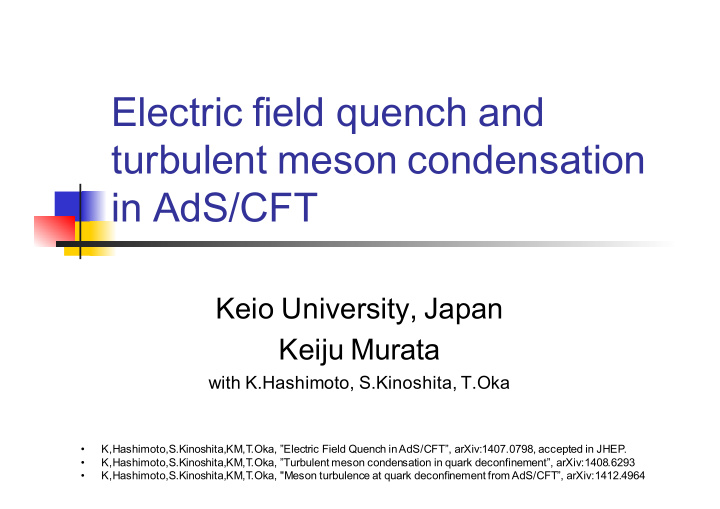



Electric field quench and turbulent meson condensation in AdS/CFT Keio University, Japan Keiju Murata with K.Hashimoto, S.Kinoshita, T.Oka • K,Hashimoto,S.Kinoshita,KM,T.Oka, ”Electric Field Quench in AdS/CFT”, arXiv:1407.0798, accepted in JHEP. • K,Hashimoto,S.Kinoshita,KM,T.Oka, ”Turbulent meson condensation in quark deconfinement”, arXiv:1408.6293 • K,Hashimoto,S.Kinoshita,KM,T.Oka, "Meson turbulence at quark deconfinement from AdS/CFT”, arXiv:1412.4964
Non-equilibrium process in AdS/CFT • N=4 SYM AdS/CFT • QCD Gravity theories • Condensed matter physics • etc… Non-equilibrium Tractable. First-principles calculation At least, there is no problem in the is not tractable. formulation(Cauchy problem). The AdS/CFT gives one of the hopeful approaches to study the non-equilibrium process in strongly coupled systems. We study the non-equilibrium process in holographic QCD induced by time dependantelectric field.
D3/D7 model Karch&Katz, 02 0 1 2 3 4 5 6 7 8 9 Nc>>Nf Nc D3 ✓ ✓ ✓ ✓ Nf D7 ✓ ✓ ✓ ✓ ✓ ✓ ✓ ✓ Near horizon lmit of D3-branes in AdS5 x S5. D7 D3 D7 D7 action � � d 8 σ S = det( h ab + 2 πα � F ab ) induced metric Electromagnetic field Fluctuation of the D7-brane This model is dual to N=2 Super symmetric QCD. = meson excitation
Static electric field Karch&O’Bannon,07 Boundary condition at AdS boundary F tx = − E SQCD z z=0 Electric current Schwinger limit E = E Sch above which non-zero electric current is generated. Albash,Filew,Johnson&Kundu,07 Erdmenger,Meyer&Shock,07 Nakamura,12 Hashimoto,Kinoshita,KM,Oka, 14 Electric field
Time dependant electric field E E f ∆ t SQCD t Boundary condition: Brane motion F tx | z =0 = − E ( t ) z z=0 Numerical Time-dependantelectric field induces calculation the brane motion. Ishii, Kinoshista, KM, Tanahashi, 14
Subcritical case electric field 0 E f /m 2 = 0 . 19 , E = E Sch m ∆ t = 2 E f At t~12, the brane moves very quickly. Our numerical calculation has crushed there. What’s happened?
Naked singularity formation singularity D-brane version of the weakly (Ricci scalar = ∞ ) turbulent instability in AdS. Bizon&Rostworowski, 11 AdS boundary world Pole volume The final fate is not a BH, Propagation of but a naked singularity. brane fluctuation dE/dt
Singularity formation implies quark deconfinement A meson excitation going through near the singularity is strongly redshifted. Initial energy / Final energy strong redshift singularity t meson excitatio Energy of mesons dissipates into the background . n “Deconfinement” of quarks.
Energy transfer from large to small scale Energy flow from large scale to small scale. Weak turbulence Production of many heavy mesons just before the deconfinement. Why are many heavy mesons produced before the deconfinement?
Deconfinement occurs due to heavy quark condensate Polyakov, 78 Pisarski&Alvaretz, 82 Patel, 84 Lucini et al, 05 Heavy mesons = long QCD strings Hanada et al, 14 Reconnection with background long QCD strings q ¯ q ¯ q q Quarks can propagate freely. Heavy meson condensation Quark deconfinement Our AdS/CFT calculation supports this idea.
Summary We studied non-equilibrium process in holographic QCD, which is induced by time-dependantelectric field. We found a weak turbulence in the D3/D7 system. There is a energy flow from large to small scale. This can be regarded as production of many heavy mesons in SQCD. Heavy meson production can cause deconfinementtransition.
Recommend
More recommend